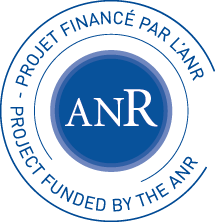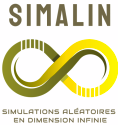Projet SIMALIN - ANR-19-CE40-0016


Contenu du site
Offres de stages de master, de thèses et de post-doctorat
- Possible ouverture d'un stage de 6 mois. Analyse numérique pour les EDP stochastiques. Offre au fil de l'eau. Contacter Ludovic Goudenège.
- Proposition de sujet de thèse. lien vers ADUM. Début septembre 2021. Lien vers le sujet PDF
- Possible ouverture d'un poste en post-doctorat d'un an. Analyse numérique pour les EDP stochastiques. Offre au fil de l'eau. Contacter Ludovic Goudenège.
Simulations Aléatoires en Dimension Infinie
(link to English version)
Membres
- Caroline Bauzet (LMA - CNRS UMR 7031) -- Mathématicienne
- Charles-Edouard Bréhier (ICJ - CNRS UMR 5208) -- Mathématicien
- Julia Charrier (I2M - CNRS UMR 7373) -- Mathématicienne
- Ludovic Goudenège (FDM - CNRS FR 3487) Porteur du projet
- Guillaume Joslin (MICS - CNRS EA 4037) -- Ingénieur
- Alexandre Richard (MICS - CNRS EA 4037 et FDM - CNRS FR 3487) -- Mathématicien
- Laurent Series (CMAP - CNRS UMR 7641) -- Ingénieur
Résumé
Ce projet vise à créer, analyser et implémenter des algorithmes numériques optimaux pour deux classes d'équations aux dérivées partielles stochastiques: des équations semi-linéaires paraboliques comme celles d'Allen-Cahn, Cahn-Hilliard, Burgers, Navier-Stokes et FitzHugh-Nagumo, et des équations hyperboliques de lois de conservation scalaires comme les équations de Burgers sans viscosité. Ces équations sont perturbées par un terme de bruit, formellement représenté par la dérivée temporelle d'un processus de Wiener, lui-même défini comme une série de mouvements Browniens développée sur une base hilbertienne. Jusqu'à présent, et dans la plupart des applications, seuls des bruits de faibles dimensions, ou des bruits blancs en temps mais qui ne dépendent pas de l'espace, ont été considérés.
Les principales difficultés théoriques et numériques proviennent du caractère infini dimensionnel et aléatoire des objets manipulés en tant qu'équations d'évolution stochastiques dans un espace de dimension infinie. C'est un sujet récent, très actif et aux nombreuses questions ouvertes, comparé au cas fini-dimensionnel où les ordres forts et faibles sont bien compris. A contrario pour un bruit en dimension infinie l'analyse et la simulation restent des challenges ouverts et attractifs, puisque les bruits infini-dimensionnels entrainent de faibles régularités en espace et en temps pour les solutions, ce qui conduit à des ordres de convergence numérique réduits par rapport aux cas déterministes et/ou fini-dimensionnels.
Basé sur les récentes avancées théoriques dans l'analyse des EDP stochastiques et l'efficacité de certaines méthodes d’échantillonnage en dimension finie, notre objectif est d'aller au-delà de l'état de l'art dans les directions suivantes: étendre les résultats concernant les ordres faibles de convergence pour les équations semi-linéaires paraboliques stochastiques lorsque les coefficients ne sont pas globalement Lipschitz, démontrer les estimations d'erreur et les ordres de convergence pour les méthodes en volumes finis appliquées aux lois de conservation scalaires stochastiques, et concevoir des techniques efficaces de réduction de variance telles que les méthodes de Monte Carlo multi-niveaux, ou dans le contexte d'échantillonnage d’événements rares. Des résultats encourageants ont été obtenus concernant les ordres forts et faibles pour un bruit de grande dimension, ouvrant ainsi la voie à la conception de schémas d'ordre supérieur.
Parallèlement à l'analyse mathématique, il est essentiel de valider les schémas d'approximations et l'analyse théorique d'erreur par des expériences numériques approfondies. La combinaison de méthodes de Monte-Carlo avancées et d'algorithmes numériques pour les EDP est une procédure non triviale dans la pratique, qui est souvent ignorée dans la littérature. Ce projet vise à examiner les aspects numériques de nouveaux schémas pour les EDP stochastiques et à créer un code adapté au traitement conjoint des estimations de type Monte-Carlo et de la structure d'approximation des équations aux dérivées partielles considérées. Des logiciels et des bibliothèques informatiques ont été développés pour la résolution des équations aux dérivées partielles, mais il semble que pour les EDP stochastiques, aucun outil de ce type ne soit disponible. Nous nous fixons comme objectif de mettre au point un tel outil pour les simulations numériques.
En conclusion, le projet vise à contribuer à l'amélioration des techniques théoriques et numériques pour la simulation des EDP stochastiques par des avancées majeures dans l’analyse des propriétés propres au modèle (régularité des solutions, comportement en temps long, etc.) et le développement de simulations numériques efficaces (techniques d'implémentation, calibration de paramètres, réduction des erreurs statistiques). Ces résultats précurseurs dans le domaine pourront naturellement se propager dans diverses applications en mathématiques et dans l’industrie.
Random Simulations in Infinite Dimension
(lien vers la version française)
Members
- Caroline Bauzet (LMA - CNRS UMR 7031) -- Mathematician
- Charles-Edouard Bréhier (ICJ - CNRS UMR 5208) -- Mathematician
- Julia Charrier (I2M - CNRS UMR 7373) -- Mathematician
- Ludovic Goudenège (FDM - CNRS FR 3487) -- Principal investigator
- Guillaume Joslin (MICS - CNRS EA 4037) -- Engineer
- Alexandre Richard (MICS - CNRS EA 4037 et FDM - CNRS FR 3487) -- Mathematician
- Laurent Series (CMAP - CNRS UMR 7641) -- Engineer
Description
Our project aims at going beyond existing results concerning the analysis and the implementation of numerical algorithms for two classes of stochastic partial differential equations: semilinear parabolic like Allen-Cahn, Cahn-Hilliard, Burgers, Navier-Stokes and FitzHugh-Nagumo equations and hyperbolic scalar conservation laws like inviscid Burgers equations. These equations are perturbed by a noise term, formally represented by the time derivative of a Wiener process, defined as a series of Brownian motions developed on a Hilbert basis. Until now, in many applications, only low-dimensional noise perturbations, or even only noise which is white in time but does not depend on space, have been considered.
One of the main theoretical and computational difficulties is that for such equations, both the solution and the stochastic forcing depend on time and space, and are thus infinite dimensional and random objects. This is a recent and very active research area, with many remaining open questions compared with the finite dimensional situation where comparison of the strong and weak orders is well-understood. However with infinite dimensional noise the analysis and simulation are much more challenging, since infinite dimensional noise yields low regularity properties for solutions, and in turn low orders of convergence for temporal and spatial numerical approximations.
Building upon recent theoretical advances in the analysis of SPDEs and the effectiveness of some existing sampling methods in finite dimension, we aim to go beyond the state of the art in the following directions: extending results concerning weak rates of convergence for stochastic semi-linear parabolic equations with non-globally Lipschitz continuous coefficients, proving error estimates and rates of convergence for finite volume methods applied to stochastic scalar conservation laws, and designing efficient variance reduction techniques like multilevel Monte Carlo methods, or in the context of rare events. Encouraging results have been obtained about strong and weak orders for a large dimensional noise opening the way to designing higher order schemes.
In parallel with mathematical analysis, it is crucial to validate developments of numerical methods and theoretical error analysis by extensive numerical experiments. The combination of advanced Monte-Carlo methods and of numerical algorithms for PDEs is a non-trivial procedure in practice, which is quite often ignored in the literature. This project aims at considering scientific computing aspects of the numerical methods for SPDEs, and in creating adapted code to be able to efficiently deal with issues arising from both the Monte-Carlo and the PDE components of the models. Efficient softwares and libraries with PDE solvers have been developed, but it seems that for SPDEs no tools of this type is available. We aim at providing such a mathematical software.
In conclusion, the project aims at contributing through theoretical and computational breakthroughs by considering all the aspects related to the simulation of SPDEs, from the analysis of properties of the model (regularity, long-time behavior, etc.) to the numerical experiments (implementation, calibration of parameters, reduction of the statistical error). It will be precursor results, with a view to spreading in various applications in mathematics and in the industry.
Références et Publications
- C. Bauzet, and F. Nabet. Convergence of a finite-volume scheme for a heat equation with a multiplicative stochastic force Finite Volumes for Complex Applications IX, Bergen, Norway, 2020. https://hal.archives-ouvertes.fr/hal-02442422v2
- C.-E. Bréhier. Analysis of a splitting scheme for a class of nonlinear stochastic Schrodinger equations. https://arxiv.org/pdf/2007.02354.pdf
- C.-E. Bréhier. Approximation of the invariant distribution for a class of ergodic SDEs with one-sided Lipschitz continuous drift coefficient using an explicit tamed Euler scheme. https://arxiv.org/pdf/2010.00512.pdf
- C.-E. Bréhier. Approximation of the invariant distribution for a class of ergodic SPDEs using an explicit tamed exponential Euler scheme. https://arxiv.org/pdf/2010.00508.pdf
- C.-E. Bréhier, and D. Cohen. Strong rates of convergence of a splitting scheme for Schrodinger equations with nonlocal interaction cubic nonlinearity and white noise dispersion. https://arxiv.org/pdf/2011.01115.pdf
- C.-E. Bréhier, and S. Rakotonirina-Ricquebourg. On asymptotic preserving schemes for a class of stochastic differential equations in averaging and diffusion approximation regimes. https://arxiv.org/pdf/2011.02341.pdf
- A. Abdulle, C.-E. Bréhier, and Gilles Vilmart. Convergence analysis of explicit stabilized integrators for parabolic semilinear stochastic PDEs. https://arxiv.org/pdf/2102.03209.pdf
- C. Bauzet, V. Castel, and J. Charrier. Existence and uniqueness result for an hyperbolic scalar conservation law with a stochastic force using a finite volume approximation. Journal of Hyperbolic Differential Equations, 2020. https://doi.org/10.1142/S0219891620500071
- J. Doghman, and L. Goudenège. A Finite Element Approximation for the Stochastic Navier-Stokes-Alpha Model.
- L. Goudenège, A. Molent, and A. Zanette. Variance Reduction Applied to Machine Learning for Pricing Bermudan/American Options in High Dimension. https://arxiv.org/pdf/1903.11275.pdf
- L. Goudenège, and B. Xie. Ergodicity of stochastic Cahn-Hilliard equations with logarithmic potentials driven by degenerate or nondegenerate noises. Journal of Differential Equations, 269(9), 6988--7014, October 2020. https://doi.org/10.1016/j.jde.2020.04.047
- R. Letournel, L. Goudenège, R. Zamansky, A. Vié, M. Massot. Revisiting the framework for intermittency in Lagrangian stochastic models for turbulent flows: a way to an original and versatile numerical approach. https://hal.archives-ouvertes.fr/hal-03177667